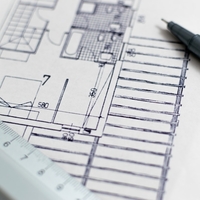By Caitlin Hoff, Health & Safety Investigator
 Whether you are adjusting to a newly acquired disability or living with a long-term disability from childhood, having an accessible living space allows you a sense of independence and mobility in your home. Most homes are not built with disabilities in mind, so modifications are often necessary for a homeowner with a physical disability or impairment. Unfortunately, it can sometimes be difficult to find resources for disability-related home modifications. Here are five steps to make your home more accessible:
Whether you are adjusting to a newly acquired disability or living with a long-term disability from childhood, having an accessible living space allows you a sense of independence and mobility in your home. Most homes are not built with disabilities in mind, so modifications are often necessary for a homeowner with a physical disability or impairment. Unfortunately, it can sometimes be difficult to find resources for disability-related home modifications. Here are five steps to make your home more accessible:
- Understand Your Needs
After living with a disability for some time, you will start to understand what accommodations you need to make life easier. These needs might extend past basic mobility and include things like special appliances, equipment, or even the use of smart technology. Apart from your own awareness of your disability, seeking counsel from an occupational therapist with experience in home modifications can provide you with additional insights and product recommendations to fit your needs. Occupational therapists can also help when it’s time to speak to a contractor by explaining your requirements and their expert suggestions.
- Visualize the Necessary Space
Using a designer or contractor who has experience with physical disabilities and wheelchair accommodations can be helpful in this next step. For disabilities that require ample space for mobility, it’s important to analyze the layout of your home. For most wheelchairs, for example, doorways should be at least 36” wide (though larger wheelchairs might require more space), and all other areas of the house should afford a 5’ turning radius to accommodate a complete change of direction in a wheelchair. Visualizing the space that you’ll need can help you and your contractor design a floor plan that best suits your lifestyle. This can also be great information to have when it comes time for interior furnishings.
- Work with Levels
Depending on your specific mobility limitations, you might need appliances, fixtures, cabinetry and furniture to be lower to the ground than typical homes provide. These modifications can range from refrigerator pull-out drawers in the kitchen to a lowered bed in the bedroom. Use the expertise of your contractor, designer, and the internet to give yourself a better idea of what you want and need. And just because a room needs certain adjustments does not mean you have to sacrifice your design aesthetics. In fact, a lowered bed is just one example of a current design trend that can benefit a person with a disability that requires lowered furniture.
- Don’t Forget the Details
Aside from the placement of large appliances and furniture, sometimes certain fixtures or tech solutions can make life tasks more manageable. Take, for example, a person with a brachial plexus injury like Klumpke’s palsy. With limited fine motor skills in his or her hands, this person would require some simple changes like replacing a traditional toggle light switch with a rocker switch or installing faucets and lights that are touch-sensitive. Taking care of these small details make daily life much easier.
Another place to turn to when you’re focusing on details is technology. Companies like ADT Security Services have developed home security and home automation technology that can double as a tool for people with disabilities. Think about it – an app that allows you to turn off different lights throughout your home or lock the doors all from a phone or an iPad is life changing. Other possible tech solutions that could help people with disabilities are: Philips Hue lightbulbs, Nest Home (security, thermostats, and more), and robotic vaccums (like Roomba or Deebot. Not only do these features add safety to a person’s home, but for someone with limited mobility they can add ease to their daily life and make independent living more feasible.
- Finance Options
Home renovations aren’t cheap, especially if you are rearranging the layout of a floor plan or installing specialty appliances. It can be especially burdensome for someone with a disability who may also be paying medical bills for equipment, medications, physical therapy, or doctor’s visits. However, there are several options that a person might consider to reduce the costs of home modifications.
- While not applicable in all situations, if you are a struggling with a newly acquired disability as the result of an accident, you may have legal rights. As the injured party, you could be awarded money to help pay for medical bills and the long-term costs of your disability.
- Another option is to contact your local disabilities advocacy group like the National Council on Independent Living. While advocating for accessibility in public and private spaces, many of these groups also set aside some of their budget to help individuals and families with necessary home modifications.
- Finally, homeowners in need of renovations for improved living quality may consider a government-backed home improvement loan like an FHA Title 1 loan Section 203(k) rehabilitation mortgage. These loans are provided by private financial institutions and are backed by the Federal Housing Administration (FHA) which make them a little easier to obtain.
 Living with a disability can certainly be difficult at times and costly, but there are resources out there that can make life better. By utilizing new technology, collaborating with experts, and brainstorming new solutions, home accessibility is attainable. And with time, it will only become more so for future generations living with disabilities.
Living with a disability can certainly be difficult at times and costly, but there are resources out there that can make life better. By utilizing new technology, collaborating with experts, and brainstorming new solutions, home accessibility is attainable. And with time, it will only become more so for future generations living with disabilities.
Bio: Caitlin Hoff uses her background in product design and her passion for health and wellness to educate consumers. She aims to shine awareness on important consumer topics that affect people every day. Through her writing, Caitlin hopes to guide families and individuals to make smarter decision and improve their overall quality of life. For more pieces by Caitlin and for more consumer health and safety news, follow https://twitter.com/ConsumerSafetyO.




No Comments
No comments yet.